Yuren Mao
CT-Agent: A Multimodal-LLM Agent for 3D CT Radiology Question Answering
May 22, 2025Abstract:Computed Tomography (CT) scan, which produces 3D volumetric medical data that can be viewed as hundreds of cross-sectional images (a.k.a. slices), provides detailed anatomical information for diagnosis. For radiologists, creating CT radiology reports is time-consuming and error-prone. A visual question answering (VQA) system that can answer radiologists' questions about some anatomical regions on the CT scan and even automatically generate a radiology report is urgently needed. However, existing VQA systems cannot adequately handle the CT radiology question answering (CTQA) task for: (1) anatomic complexity makes CT images difficult to understand; (2) spatial relationship across hundreds slices is difficult to capture. To address these issues, this paper proposes CT-Agent, a multimodal agentic framework for CTQA. CT-Agent adopts anatomically independent tools to break down the anatomic complexity; furthermore, it efficiently captures the across-slice spatial relationship with a global-local token compression strategy. Experimental results on two 3D chest CT datasets, CT-RATE and RadGenome-ChestCT, verify the superior performance of CT-Agent.
Text-to-Pipeline: Bridging Natural Language and Data Preparation Pipelines
May 21, 2025Abstract:Data preparation (DP) transforms raw data into a form suitable for downstream applications, typically by composing operations into executable pipelines. Building such pipelines is time-consuming and requires sophisticated programming skills. If we can build the pipelines with natural language (NL), the technical barrier of DP will be significantly reduced. However, constructing DP pipelines from NL instructions remains underexplored. To fill the gap, we introduce Text-to-Pipeline, a new task that translates NL data preparation instructions into DP pipelines. Furthermore, we develop a benchmark named PARROT to support systematic evaluation. To simulate realistic DP scenarios, we mined transformation patterns from production pipelines and instantiated them on 23,009 real-world tables collected from six public sources. The resulting benchmark comprises ~18,000 pipelines covering 16 core DP operators. We evaluated cutting-edge large language models on PARROTand observed that they only solved 72.86% of the cases, revealing notable limitations in instruction understanding and multi-step reasoning. To address this, we propose Pipeline-Agent, a stronger baseline that iteratively predicts and executes operations with intermediate table feedback, achieving the best performance of 76.17%. Despite this improvement, there remains substantial room for progress on Text-to-Pipeline. Our data, codes, and evaluation tools are available at https://anonymous.4open.science/r/Text-to-Pipeline.
scAgent: Universal Single-Cell Annotation via a LLM Agent
Apr 07, 2025Abstract:Cell type annotation is critical for understanding cellular heterogeneity. Based on single-cell RNA-seq data and deep learning models, good progress has been made in annotating a fixed number of cell types within a specific tissue. However, universal cell annotation, which can generalize across tissues, discover novel cell types, and extend to novel cell types, remains less explored. To fill this gap, this paper proposes scAgent, a universal cell annotation framework based on Large Language Models (LLMs). scAgent can identify cell types and discover novel cell types in diverse tissues; furthermore, it is data efficient to learn novel cell types. Experimental studies in 160 cell types and 35 tissues demonstrate the superior performance of scAgent in general cell-type annotation, novel cell discovery, and extensibility to novel cell type.
G-Boost: Boosting Private SLMs with General LLMs
Mar 13, 2025Abstract:Due to the limited computational resources, most Large Language Models (LLMs) developers can only fine-tune Small Language Models (SLMs) on their own data. These private SLMs typically have limited effectiveness. To boost the performance of private SLMs, this paper proposes to ask general LLMs for help. The general LLMs can be APIs or larger LLMs whose inference cost the developers can afford. Specifically, we propose the G-Boost framework where a private SLM adaptively performs collaborative inference with a general LLM under the guide of process reward. Experiments demonstrate that our framework can significantly boost the performance of private SLMs.
Snoopy: Effective and Efficient Semantic Join Discovery via Proxy Columns
Feb 24, 2025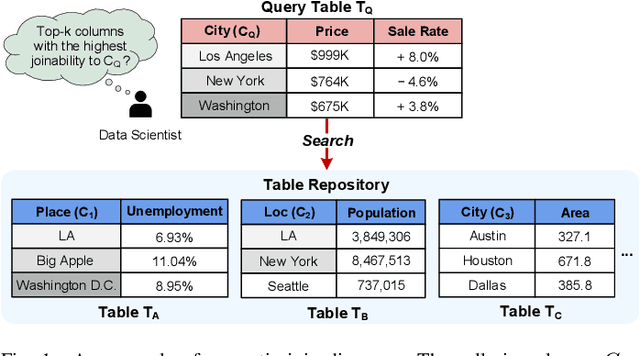
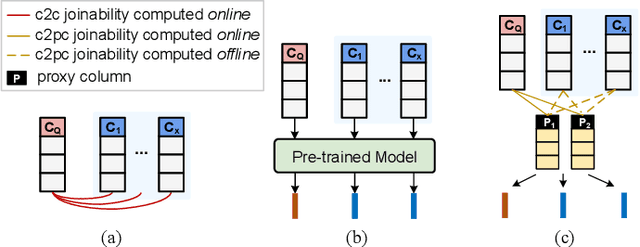
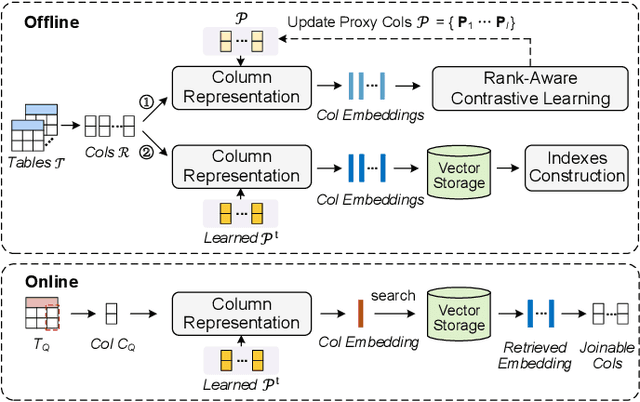
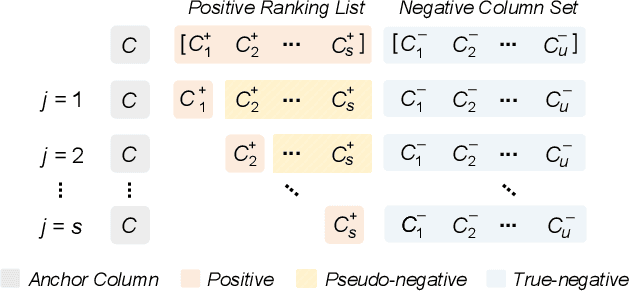
Abstract:Semantic join discovery, which aims to find columns in a table repository with high semantic joinabilities to a query column, is crucial for dataset discovery. Existing methods can be divided into two categories: cell-level methods and column-level methods. However, neither of them ensures both effectiveness and efficiency simultaneously. Cell-level methods, which compute the joinability by counting cell matches between columns, enjoy ideal effectiveness but suffer poor efficiency. In contrast, column-level methods, which determine joinability only by computing the similarity of column embeddings, enjoy proper efficiency but suffer poor effectiveness due to the issues occurring in their column embeddings: (i) semantics-joinability-gap, (ii) size limit, and (iii) permutation sensitivity. To address these issues, this paper proposes to compute column embeddings via proxy columns; furthermore, a novel column-level semantic join discovery framework, Snoopy, is presented, leveraging proxy-column-based embeddings to bridge effectiveness and efficiency. Specifically, the proposed column embeddings are derived from the implicit column-to-proxy-column relationships, which are captured by the lightweight approximate-graph-matching-based column projection.To acquire good proxy columns for guiding the column projection, we introduce a rank-aware contrastive learning paradigm. Extensive experiments on four real-world datasets demonstrate that Snoopy outperforms SOTA column-level methods by 16% in Recall@25 and 10% in NDCG@25, and achieves superior efficiency--being at least 5 orders of magnitude faster than cell-level solutions, and 3.5x faster than existing column-level methods.
FIT-RAG: Black-Box RAG with Factual Information and Token Reduction
Mar 21, 2024Abstract:Due to the extraordinarily large number of parameters, fine-tuning Large Language Models (LLMs) to update long-tail or out-of-date knowledge is impractical in lots of applications. To avoid fine-tuning, we can alternatively treat a LLM as a black-box (i.e., freeze the parameters of the LLM) and augment it with a Retrieval-Augmented Generation (RAG) system, namely black-box RAG. Recently, black-box RAG has achieved success in knowledge-intensive tasks and has gained much attention. Existing black-box RAG methods typically fine-tune the retriever to cater to LLMs' preferences and concatenate all the retrieved documents as the input, which suffers from two issues: (1) Ignorance of Factual Information. The LLM preferred documents may not contain the factual information for the given question, which can mislead the retriever and hurt the effectiveness of black-box RAG; (2) Waste of Tokens. Simply concatenating all the retrieved documents brings large amounts of unnecessary tokens for LLMs, which degenerates the efficiency of black-box RAG. To address these issues, this paper proposes a novel black-box RAG framework which utilizes the factual information in the retrieval and reduces the number of tokens for augmentation, dubbed FIT-RAG. FIT-RAG utilizes the factual information by constructing a bi-label document scorer. Besides, it reduces the tokens by introducing a self-knowledge recognizer and a sub-document-level token reducer. FIT-RAG achieves both superior effectiveness and efficiency, which is validated by extensive experiments across three open-domain question-answering datasets: TriviaQA, NQ and PopQA. FIT-RAG can improve the answering accuracy of Llama2-13B-Chat by 14.3\% on TriviaQA, 19.9\% on NQ and 27.5\% on PopQA, respectively. Furthermore, it can save approximately half of the tokens on average across the three datasets.
FinSQL: Model-Agnostic LLMs-based Text-to-SQL Framework for Financial Analysis
Jan 19, 2024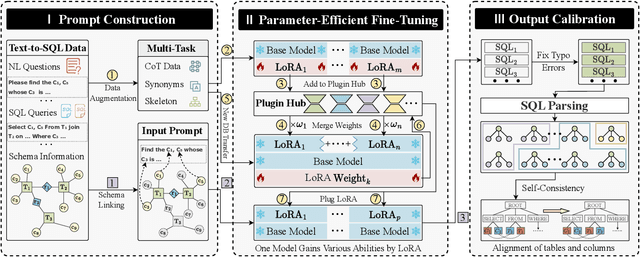



Abstract:Text-to-SQL, which provides zero-code interface for operating relational databases, has gained much attention in financial analysis; because, financial professionals may not well-skilled in SQL programming. However, until now, there is no practical Text-to-SQL benchmark dataset for financial analysis, and existing Text-to-SQL methods have not considered the unique characteristics of databases in financial applications, such as commonly existing wide tables. To address these issues, we collect a practical Text-to-SQL benchmark dataset and propose a model-agnostic Large Language Model (LLMs)-based Text-to-SQL framework for financial analysis. The benchmark dataset, BULL, is collected from the practical financial analysis business of Hundsun Technologies Inc., including databases for fund, stock, and macro economy. Besides, the proposed LLMs-based Text-to-SQL framework, FinSQL, provides a systematic treatment for financial Text-to-SQL from the perspectives of prompt construction, parameter-efficient fine-tuning and output calibration. Extensive experimental results on BULL demonstrate that FinSQL achieves the state-of-the-art Text-to-SQL performance at a small cost; furthermore, FinSQL can bring up to 36.64% performance improvement in scenarios requiring few-shot cross-database model transfer.
MultiEM: Efficient and Effective Unsupervised Multi-Table Entity Matching
Aug 02, 2023Abstract:Entity Matching (EM), which aims to identify all entity pairs referring to the same real-world entity from relational tables, is one of the most important tasks in real-world data management systems. Due to the labeling process of EM being extremely labor-intensive, unsupervised EM is more applicable than supervised EM in practical scenarios. Traditional unsupervised EM assumes that all entities come from two tables; however, it is more common to match entities from multiple tables in practical applications, that is, multi-table entity matching (multi-table EM). Unfortunately, effective and efficient unsupervised multi-table EM remains under-explored. To fill this gap, this paper formally studies the problem of unsupervised multi-table entity matching and proposes an effective and efficient solution, termed as MultiEM. MultiEM is a parallelable pipeline of enhanced entity representation, table-wise hierarchical merging, and density-based pruning. Extensive experimental results on six real-world benchmark datasets demonstrate the superiority of MultiEM in terms of effectiveness and efficiency.
C3: Zero-shot Text-to-SQL with ChatGPT
Jul 14, 2023Abstract:This paper proposes a ChatGPT-based zero-shot Text-to-SQL method, dubbed C3, which achieves 82.3\% in terms of execution accuracy on the holdout test set of Spider and becomes the state-of-the-art zero-shot Text-to-SQL method on the Spider Challenge. C3 consists of three key components: Clear Prompting (CP), Calibration with Hints (CH), and Consistent Output (CO), which are corresponding to the model input, model bias and model output respectively. It provides a systematic treatment for zero-shot Text-to-SQL. Extensive experiments have been conducted to verify the effectiveness and efficiency of our proposed method.
Knowledge-refined Denoising Network for Robust Recommendation
Apr 28, 2023
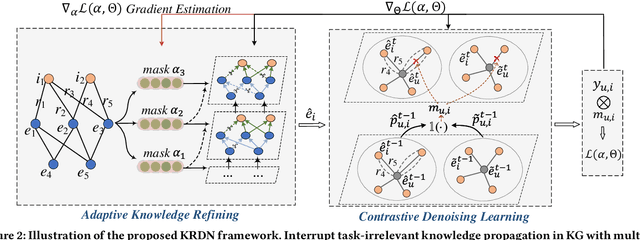


Abstract:Knowledge graph (KG), which contains rich side information, becomes an essential part to boost the recommendation performance and improve its explainability. However, existing knowledge-aware recommendation methods directly perform information propagation on KG and user-item bipartite graph, ignoring the impacts of \textit{task-irrelevant knowledge propagation} and \textit{vulnerability to interaction noise}, which limits their performance. To solve these issues, we propose a robust knowledge-aware recommendation framework, called \textit{Knowledge-refined Denoising Network} (KRDN), to prune the task-irrelevant knowledge associations and noisy implicit feedback simultaneously. KRDN consists of an adaptive knowledge refining strategy and a contrastive denoising mechanism, which are able to automatically distill high-quality KG triplets for aggregation and prune noisy implicit feedback respectively. Besides, we also design the self-adapted loss function and the gradient estimator for model optimization. The experimental results on three benchmark datasets demonstrate the effectiveness and robustness of KRDN over the state-of-the-art knowledge-aware methods like KGIN, MCCLK, and KGCL, and also outperform robust recommendation models like SGL and SimGCL.
 Add to Chrome
Add to Chrome Add to Firefox
Add to Firefox Add to Edge
Add to Edge